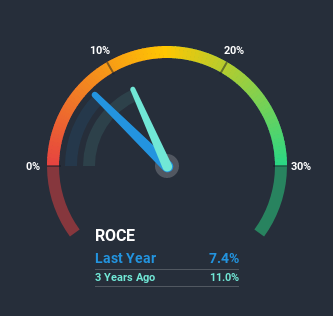- Hong Kong
- /
- Food and Staples Retail
- /
- SEHK:814
Our Take On The Returns On Capital At Beijing Jingkelong (HKG:814)
What trends should we look for it we want to identify stocks that can multiply in value over the long term? Typically, we'll want to notice a trend of growing return on capital employed (ROCE) and alongside that, an expanding base of capital employed. Basically this means that a company has profitable initiatives that it can continue to reinvest in, which is a trait of a compounding machine. However, after briefly looking over the numbers, we don't think Beijing Jingkelong (HKG:814) has the makings of a multi-bagger going forward, but let's have a look at why that may be.
What is Return On Capital Employed (ROCE)?
Just to clarify if you're unsure, ROCE is a metric for evaluating how much pre-tax income (in percentage terms) a company earns on the capital invested in its business. The formula for this calculation on Beijing Jingkelong is:
Return on Capital Employed = Earnings Before Interest and Tax (EBIT) ÷ (Total Assets - Current Liabilities)
0.074 = CN¥266m ÷ (CN¥8.2b - CN¥4.6b) (Based on the trailing twelve months to September 2020).
Thus, Beijing Jingkelong has an ROCE of 7.4%. Ultimately, that's a low return and it under-performs the Consumer Retailing industry average of 9.7%.
Check out our latest analysis for Beijing Jingkelong

While the past is not representative of the future, it can be helpful to know how a company has performed historically, which is why we have this chart above. If you want to delve into the historical earnings, revenue and cash flow of Beijing Jingkelong, check out these free graphs here.
So How Is Beijing Jingkelong's ROCE Trending?
In terms of Beijing Jingkelong's historical ROCE trend, it doesn't exactly demand attention. The company has consistently earned 7.4% for the last five years, and the capital employed within the business has risen 26% in that time. Given the company has increased the amount of capital employed, it appears the investments that have been made simply don't provide a high return on capital.
On a separate but related note, it's important to know that Beijing Jingkelong has a current liabilities to total assets ratio of 56%, which we'd consider pretty high. This effectively means that suppliers (or short-term creditors) are funding a large portion of the business, so just be aware that this can introduce some elements of risk. While it's not necessarily a bad thing, it can be beneficial if this ratio is lower.
The Key Takeaway
In conclusion, Beijing Jingkelong has been investing more capital into the business, but returns on that capital haven't increased. Unsurprisingly, the stock has only gained 3.3% over the last five years, which potentially indicates that investors are accounting for this going forward. As a result, if you're hunting for a multi-bagger, we think you'd have more luck elsewhere.
One more thing: We've identified 4 warning signs with Beijing Jingkelong (at least 1 which is concerning) , and understanding them would certainly be useful.
While Beijing Jingkelong may not currently earn the highest returns, we've compiled a list of companies that currently earn more than 25% return on equity. Check out this free list here.
When trading Beijing Jingkelong or any other investment, use the platform considered by many to be the Professional's Gateway to the Worlds Market, Interactive Brokers. You get the lowest-cost* trading on stocks, options, futures, forex, bonds and funds worldwide from a single integrated account. Promoted
Valuation is complex, but we're here to simplify it.
Discover if Beijing Jingkelong might be undervalued or overvalued with our detailed analysis, featuring fair value estimates, potential risks, dividends, insider trades, and its financial condition.
Access Free AnalysisThis article by Simply Wall St is general in nature. It does not constitute a recommendation to buy or sell any stock, and does not take account of your objectives, or your financial situation. We aim to bring you long-term focused analysis driven by fundamental data. Note that our analysis may not factor in the latest price-sensitive company announcements or qualitative material. Simply Wall St has no position in any stocks mentioned.
*Interactive Brokers Rated Lowest Cost Broker by StockBrokers.com Annual Online Review 2020
Have feedback on this article? Concerned about the content? Get in touch with us directly. Alternatively, email editorial-team (at) simplywallst.com.
About SEHK:814
Beijing Jingkelong
Engages in the retail and wholesale distribution of daily consumer products.
Good value with mediocre balance sheet.
Market Insights
Community Narratives



